Mouxiang Chen
Posterior-GRPO: Rewarding Reasoning Processes in Code Generation
Aug 07, 2025Abstract:Reinforcement learning (RL) has significantly advanced code generation for large language models (LLMs). However, current paradigms rely on outcome-based rewards from test cases, neglecting the quality of the intermediate reasoning process. While supervising the reasoning process directly is a promising direction, it is highly susceptible to reward hacking, where the policy model learns to exploit the reasoning reward signal without improving final outcomes. To address this, we introduce a unified framework that can effectively incorporate the quality of the reasoning process during RL. First, to enable reasoning evaluation, we develop LCB-RB, a benchmark comprising preference pairs of superior and inferior reasoning processes. Second, to accurately score reasoning quality, we introduce an Optimized-Degraded based (OD-based) method for reward model training. This method generates high-quality preference pairs by systematically optimizing and degrading initial reasoning paths along curated dimensions of reasoning quality, such as factual accuracy, logical rigor, and coherence. A 7B parameter reward model with this method achieves state-of-the-art (SOTA) performance on LCB-RB and generalizes well to other benchmarks. Finally, we introduce Posterior-GRPO (P-GRPO), a novel RL method that conditions process-based rewards on task success. By selectively applying rewards to the reasoning processes of only successful outcomes, P-GRPO effectively mitigates reward hacking and aligns the model's internal reasoning with final code correctness. A 7B parameter model with P-GRPO achieves superior performance across diverse code generation tasks, outperforming outcome-only baselines by 4.5%, achieving comparable performance to GPT-4-Turbo. We further demonstrate the generalizability of our approach by extending it to mathematical tasks. Our models, dataset, and code are publicly available.
The Power of Architecture: Deep Dive into Transformer Architectures for Long-Term Time Series Forecasting
Jul 17, 2025



Abstract:Transformer-based models have recently become dominant in Long-term Time Series Forecasting (LTSF), yet the variations in their architecture, such as encoder-only, encoder-decoder, and decoder-only designs, raise a crucial question: What Transformer architecture works best for LTSF tasks? However, existing models are often tightly coupled with various time-series-specific designs, making it difficult to isolate the impact of the architecture itself. To address this, we propose a novel taxonomy that disentangles these designs, enabling clearer and more unified comparisons of Transformer architectures. Our taxonomy considers key aspects such as attention mechanisms, forecasting aggregations, forecasting paradigms, and normalization layers. Through extensive experiments, we uncover several key insights: bi-directional attention with joint-attention is most effective; more complete forecasting aggregation improves performance; and the direct-mapping paradigm outperforms autoregressive approaches. Furthermore, our combined model, utilizing optimal architectural choices, consistently outperforms several existing models, reinforcing the validity of our conclusions. We hope these findings offer valuable guidance for future research on Transformer architectural designs in LTSF. Our code is available at https://github.com/HALF111/TSF_architecture.
SWE-Flow: Synthesizing Software Engineering Data in a Test-Driven Manner
Jun 11, 2025Abstract:We introduce **SWE-Flow**, a novel data synthesis framework grounded in Test-Driven Development (TDD). Unlike existing software engineering data that rely on human-submitted issues, **SWE-Flow** automatically infers incremental development steps directly from unit tests, which inherently encapsulate high-level requirements. The core of **SWE-Flow** is the construction of a Runtime Dependency Graph (RDG), which precisely captures function interactions, enabling the generation of a structured, step-by-step *development schedule*. At each step, **SWE-Flow** produces a partial codebase, the corresponding unit tests, and the necessary code modifications, resulting in fully verifiable TDD tasks. With this approach, we generated 16,061 training instances and 2,020 test instances from real-world GitHub projects, creating the **SWE-Flow-Eval** benchmark. Our experiments show that fine-tuning open model on this dataset significantly improves performance in TDD-based coding. To facilitate further research, we release all code, datasets, models, and Docker images at [Github](https://github.com/Hambaobao/SWE-Flow).
Parallel Scaling Law for Language Models
May 15, 2025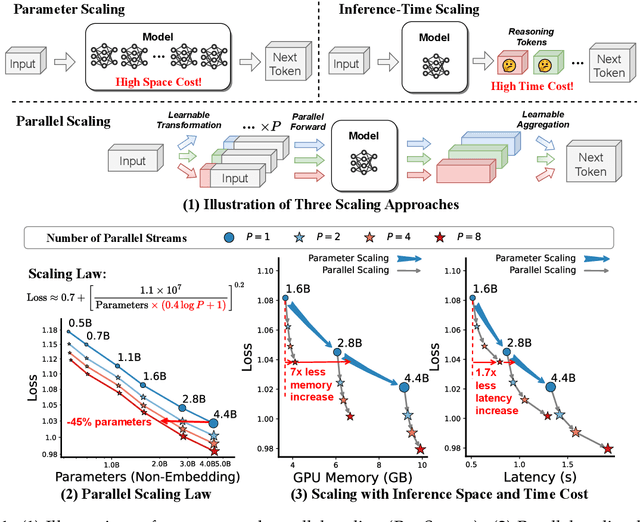

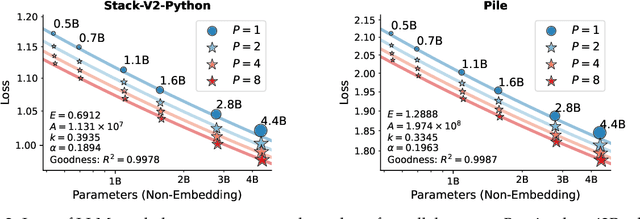

Abstract:It is commonly believed that scaling language models should commit a significant space or time cost, by increasing the parameters (parameter scaling) or output tokens (inference-time scaling). We introduce the third and more inference-efficient scaling paradigm: increasing the model's parallel computation during both training and inference time. We apply $P$ diverse and learnable transformations to the input, execute forward passes of the model in parallel, and dynamically aggregate the $P$ outputs. This method, namely parallel scaling (ParScale), scales parallel computation by reusing existing parameters and can be applied to any model structure, optimization procedure, data, or task. We theoretically propose a new scaling law and validate it through large-scale pre-training, which shows that a model with $P$ parallel streams is similar to scaling the parameters by $O(\log P)$ while showing superior inference efficiency. For example, ParScale can use up to 22$\times$ less memory increase and 6$\times$ less latency increase compared to parameter scaling that achieves the same performance improvement. It can also recycle an off-the-shelf pre-trained model into a parallelly scaled one by post-training on a small amount of tokens, further reducing the training budget. The new scaling law we discovered potentially facilitates the deployment of more powerful models in low-resource scenarios, and provides an alternative perspective for the role of computation in machine learning.
Self-Explained Keywords Empower Large Language Models for Code Generation
Oct 21, 2024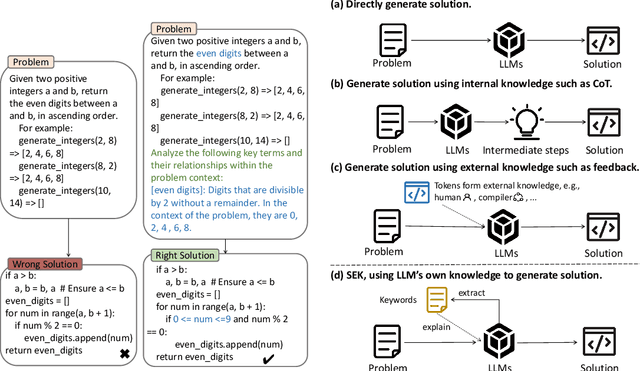
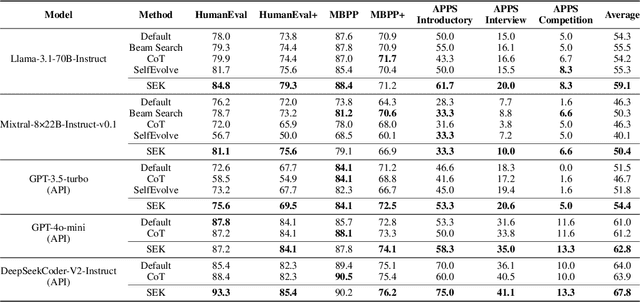

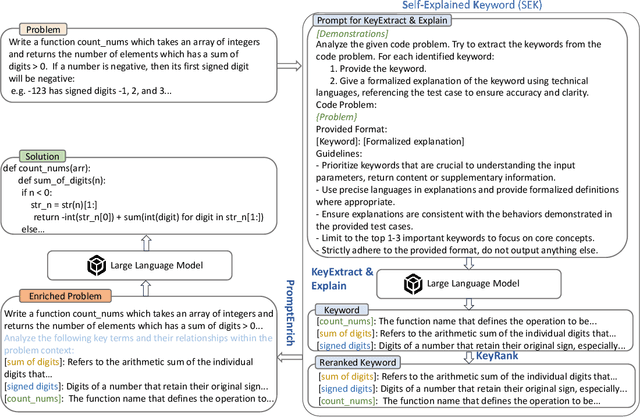
Abstract:Large language models (LLMs) have achieved impressive performance in code generation. However, due to the long-tail distribution of LLMs' training data, low-frequency terms are typically underrepresented in the training process. Consequently, LLMs often misunderstand or overlook problem-specific, low-frequency keywords during code generation, compromising the accuracy of the generated code. To address this, we propose a novel technique named SEK(\textbf{S}elf-\textbf{E}xplained \textbf{K}eywords), which empowers an LLM for better code generation by extracting and explaining the key terms in the problem description with the LLM itself and ranking them based on frequency. Comprehensive experiments across three benchmarks, i.e., HumanEval(+), MBPP(+), and APPS, with five representative LLMs, show that SEK can significantly improve LLMs in code generation, yielding substantial and consistent gains. For instance, SEK improves the Pass@1 of DeepSeek-Coder-V2-Instruct from 85.4\% to 93.3\% on the Humaneval benchmark. Further analysis confirms that SEK enables the LLMs to shift their attention from low-frequency keywords to their corresponding high-frequency counterparts.
B4: Towards Optimal Assessment of Plausible Code Solutions with Plausible Tests
Sep 13, 2024



Abstract:Selecting the best code solution from multiple generated ones is an essential task in code generation, which can be achieved by using some reliable validators (e.g., developer-written test cases) for assistance. Since reliable test cases are not always available and can be expensive to build in practice, researchers propose to automatically generate test cases to assess code solutions. However, when both code solutions and test cases are plausible and not reliable, selecting the best solution becomes challenging. Although some heuristic strategies have been proposed to tackle this problem, they lack a strong theoretical guarantee and it is still an open question whether an optimal selection strategy exists. Our work contributes in two ways. First, we show that within a Bayesian framework, the optimal selection strategy can be defined based on the posterior probability of the observed passing states between solutions and tests. The problem of identifying the best solution is then framed as an integer programming problem. Second, we propose an efficient approach for approximating this optimal (yet uncomputable) strategy, where the approximation error is bounded by the correctness of prior knowledge. We then incorporate effective prior knowledge to tailor code generation tasks. Both theoretical and empirical studies confirm that existing heuristics are limited in selecting the best solutions with plausible test cases. Our proposed approximated optimal strategy B4 significantly surpasses existing heuristics in selecting code solutions generated by large language models (LLMs) with LLM-generated tests, achieving a relative performance improvement by up to 50% over the strongest heuristic and 246% over the random selection in the most challenging scenarios. Our code is publicly available at https://github.com/ZJU-CTAG/B4.
VisionTS: Visual Masked Autoencoders Are Free-Lunch Zero-Shot Time Series Forecasters
Aug 30, 2024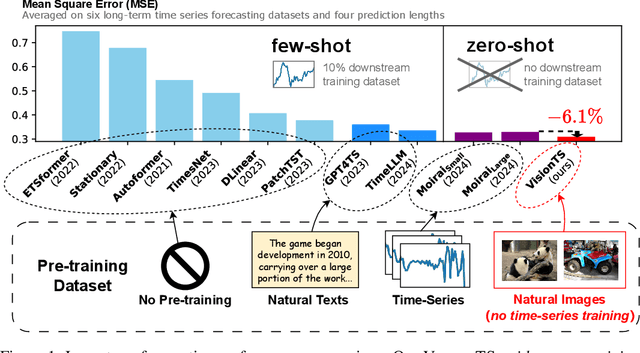

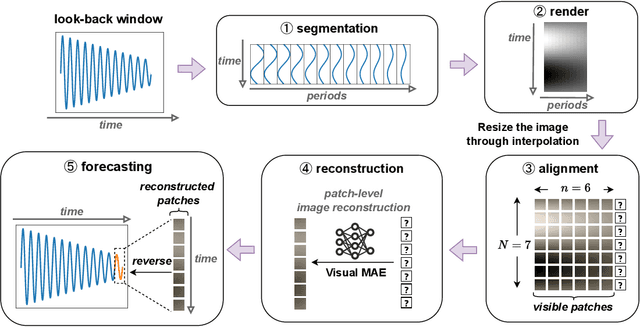
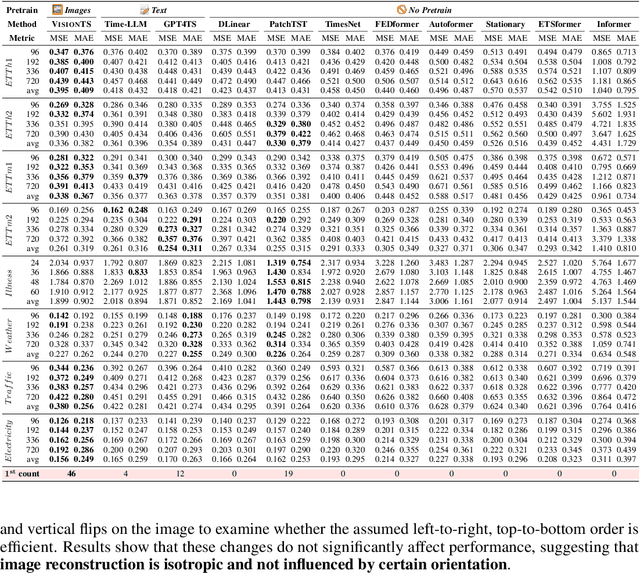
Abstract:Foundation models have emerged as a promising approach in time series forecasting (TSF). Existing approaches either fine-tune large language models (LLMs) or build large-scale time-series datasets to develop TSF foundation models. However, these methods face challenges due to the severe cross-domain gap or in-domain heterogeneity. In this paper, we explore a new road to building a TSF foundation model from rich and high-quality natural images, based on the intrinsic similarities between images and time series. To bridge the gap between the two domains, we reformulate the TSF task as an image reconstruction task, which is further processed by a visual masked autoencoder (MAE) self-supervised pre-trained on the ImageNet dataset. Surprisingly, without further adaptation in the time-series domain, the proposed VisionTS could achieve superior zero-shot forecasting performance compared to existing TSF foundation models. With minimal fine-tuning, VisionTS could further improve the forecasting and achieve state-of-the-art performance in most cases. These findings suggest that visual models could be a free lunch for TSF and highlight the potential for future cross-domain research between computer vision and TSF. Our code is publicly available at https://github.com/Keytoyze/VisionTS.
JumpCoder: Go Beyond Autoregressive Coder via Online Modification
Jan 15, 2024



Abstract:While existing code large language models (code LLMs) exhibit impressive capabilities in code generation, their autoregressive sequential generation inherently lacks reversibility. This limitation hinders them from timely correcting previous missing statements during coding as humans do, often leading to error propagation and suboptimal performance. We introduce JumpCoder, a novel modelagnostic framework that enables online modification and non-sequential generation to augment the code LLMs. The key idea behind JumpCoder is to insert new code into the currently generated code when necessary during generation, which is achieved through an auxiliary infilling model that works in tandem with the code LLM. Since identifying the best infill position beforehand is intractable, we adopt an infill-first, judge-later strategy, which experiments with filling at the $k$ most critical positions following the generation of each line, and uses an Abstract Syntax Tree (AST) parser alongside the Generation Model Scoring to effectively judge the validity of each potential infill. Extensive experiments using six state-of-the-art code LLMs across multiple benchmarks consistently indicate significant improvements over all baselines. Notably, JumpCoder assists code LLMs in achieving up to a 3.6% increase in Pass@1 for Python, 6.3% for Java, and 3.7% for C++ in the multilingual HumanEval benchmarks. Our code is public at https://github.com/Keytoyze/JumpCoder.
ULTRA-DP: Unifying Graph Pre-training with Multi-task Graph Dual Prompt
Oct 23, 2023
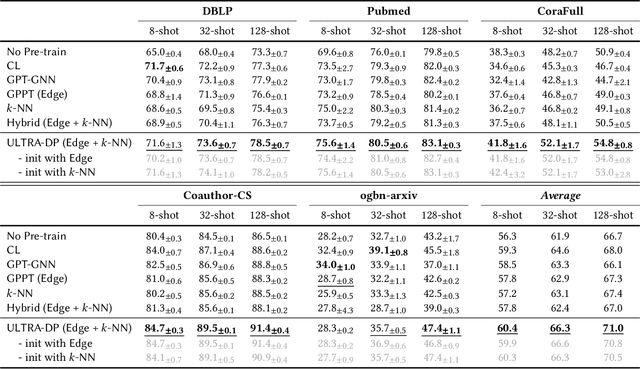
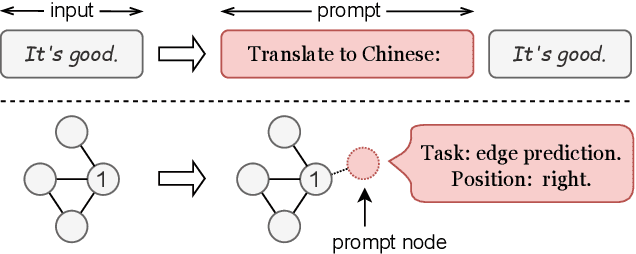
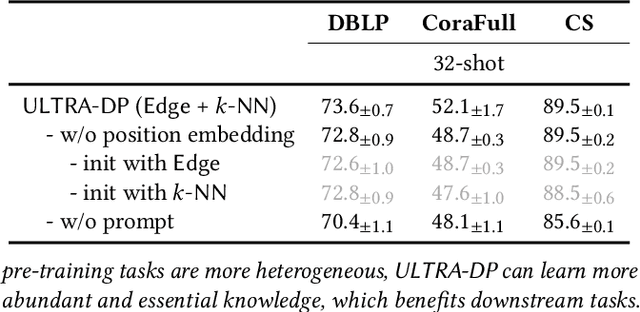
Abstract:Recent research has demonstrated the efficacy of pre-training graph neural networks (GNNs) to capture the transferable graph semantics and enhance the performance of various downstream tasks. However, the semantic knowledge learned from pretext tasks might be unrelated to the downstream task, leading to a semantic gap that limits the application of graph pre-training. To reduce this gap, traditional approaches propose hybrid pre-training to combine various pretext tasks together in a multi-task learning fashion and learn multi-grained knowledge, which, however, cannot distinguish tasks and results in some transferable task-specific knowledge distortion by each other. Moreover, most GNNs cannot distinguish nodes located in different parts of the graph, making them fail to learn position-specific knowledge and lead to suboptimal performance. In this work, inspired by the prompt-based tuning in natural language processing, we propose a unified framework for graph hybrid pre-training which injects the task identification and position identification into GNNs through a prompt mechanism, namely multi-task graph dual prompt (ULTRA-DP). Based on this framework, we propose a prompt-based transferability test to find the most relevant pretext task in order to reduce the semantic gap. To implement the hybrid pre-training tasks, beyond the classical edge prediction task (node-node level), we further propose a novel pre-training paradigm based on a group of $k$-nearest neighbors (node-group level). The combination of them across different scales is able to comprehensively express more structural semantics and derive richer multi-grained knowledge. Extensive experiments show that our proposed ULTRA-DP can significantly enhance the performance of hybrid pre-training methods and show the generalizability to other pre-training tasks and backbone architectures.
Calibration of Time-Series Forecasting Transformers: Detecting and Adapting Context-Driven Distribution Shift
Oct 23, 2023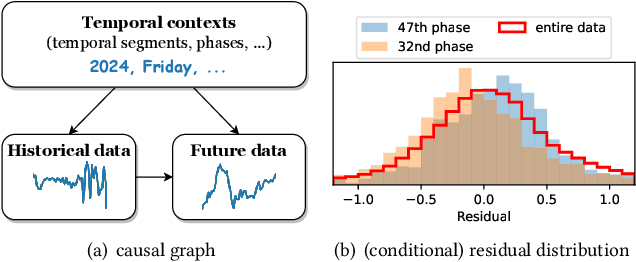
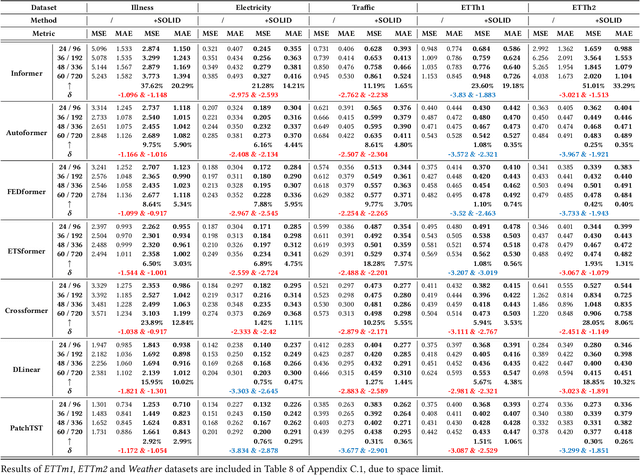
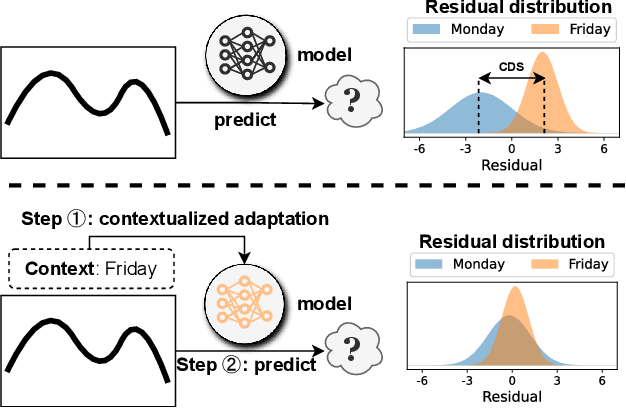
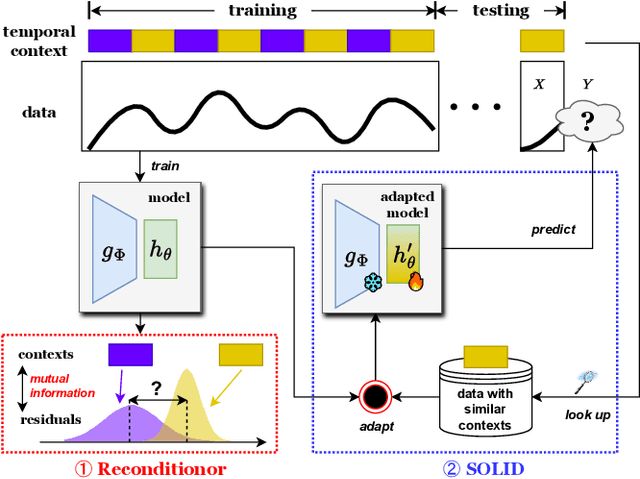
Abstract:Recent years have witnessed the success of introducing Transformers to time series forecasting. From a data generation perspective, we illustrate that existing Transformers are susceptible to distribution shifts driven by temporal contexts, whether observed or unobserved. Such context-driven distribution shift (CDS) introduces biases in predictions within specific contexts and poses challenges for conventional training paradigm. In this paper, we introduce a universal calibration methodology for the detection and adaptation of CDS with a trained Transformer model. To this end, we propose a novel CDS detector, termed the "residual-based CDS detector" or "Reconditionor", which quantifies the model's vulnerability to CDS by evaluating the mutual information between prediction residuals and their corresponding contexts. A high Reconditionor score indicates a severe susceptibility, thereby necessitating model adaptation. In this circumstance, we put forth a straightforward yet potent adapter framework for model calibration, termed the "sample-level contextualized adapter" or "SOLID". This framework involves the curation of a contextually similar dataset to the provided test sample and the subsequent fine-tuning of the model's prediction layer with a limited number of steps. Our theoretical analysis demonstrates that this adaptation strategy is able to achieve an optimal equilibrium between bias and variance. Notably, our proposed Reconditionor and SOLID are model-agnostic and readily adaptable to a wide range of Transformers. Extensive experiments show that SOLID consistently enhances the performance of current SOTA Transformers on real-world datasets, especially on cases with substantial CDS detected by the proposed Reconditionor, thus validate the effectiveness of the calibration approach.
 Add to Chrome
Add to Chrome Add to Firefox
Add to Firefox Add to Edge
Add to Edge